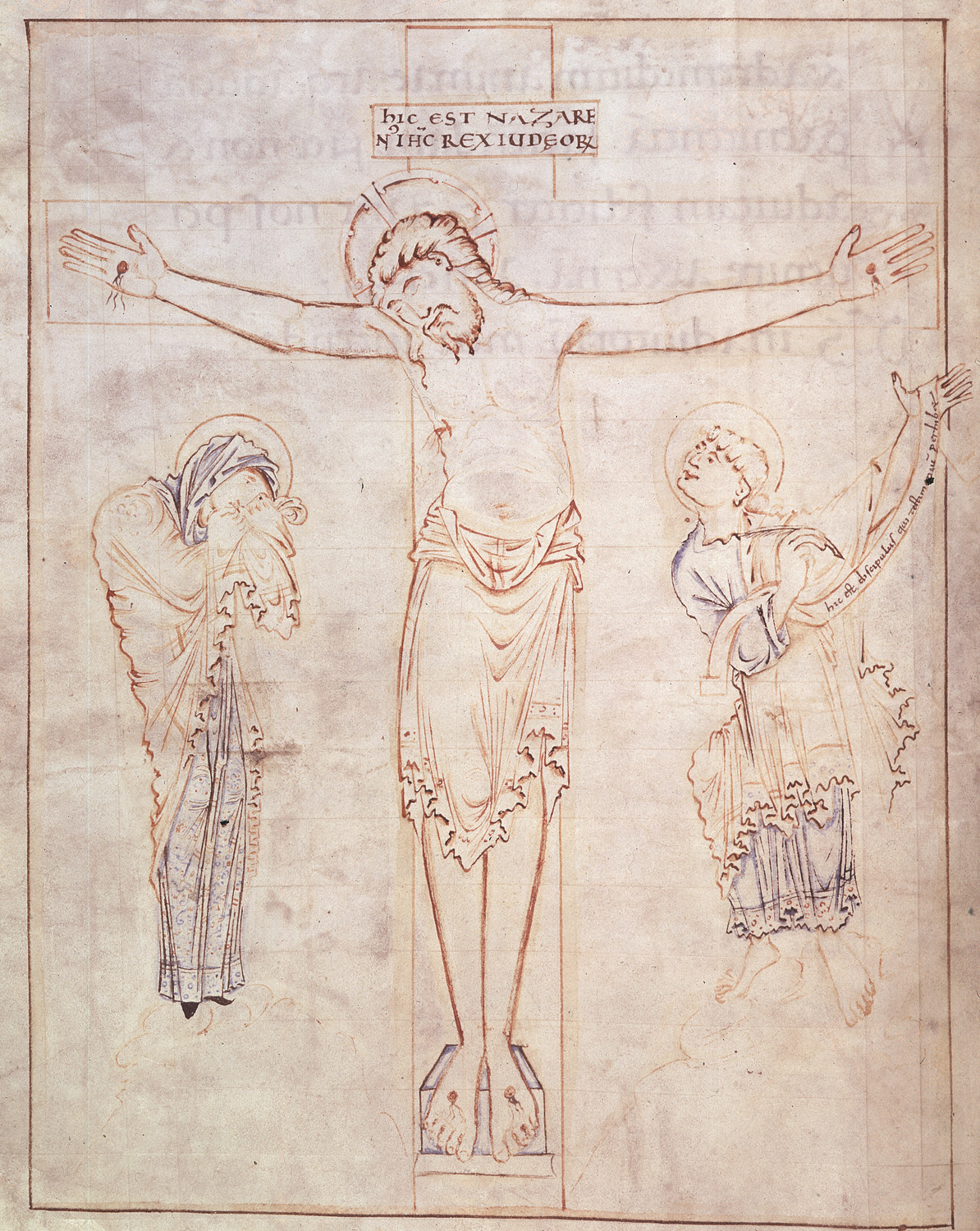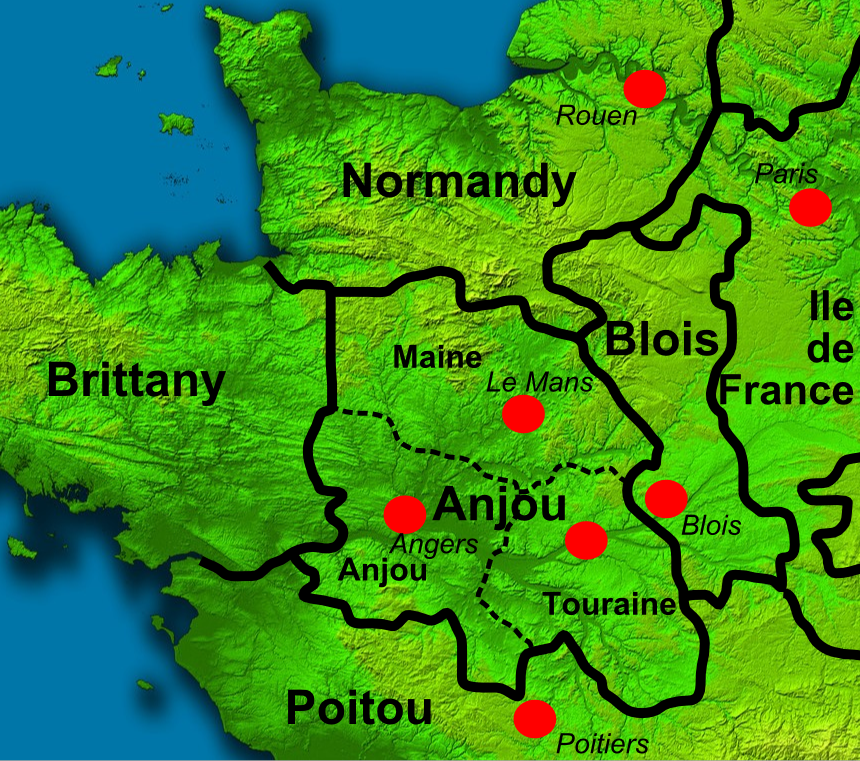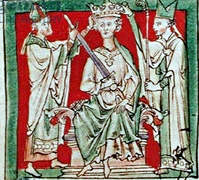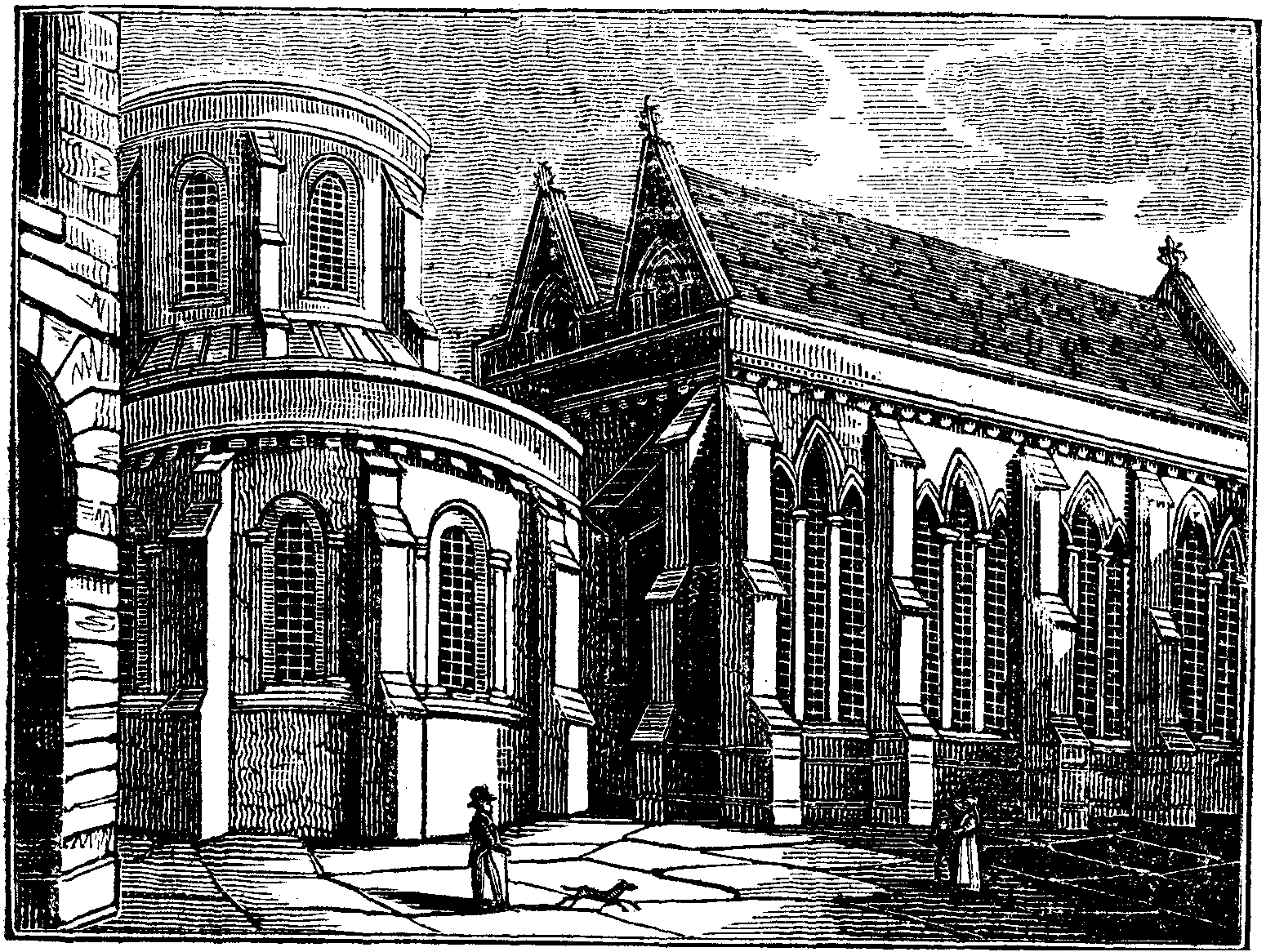|
Geoffrey De Mandeville, 1st Earl Of Essex
Geoffrey de Mandeville II, 1st Earl of Essex (died September 1144) was a prominent figure during the reign of King Stephen of England. His biographer, the 19th-century historian J. H. Round, called him "the most perfect and typical presentment of the feudal and anarchic spirit that stamps the reign of Stephen". That characterisation has been disputed since the later 20th century. Early career He succeeded his father, William, sometime before 1129, possibly as early as 1116. A key portion of the family patrimony in Essex was in the King's hands. William had incurred a debt to the crown, perhaps in part due to a large fine levied in 1101 by Henry I due to his displeasure at the escape of the important political prisoner Ranulph Flambard while William was in charge of the Tower of London. The King also held the substantial estate of Geoffrey's maternal grandfather Eudo ''le Dapifer'' to which Geoffrey laid claim. Geoffrey gained Eudo's lands and his father's offices during the ... [...More Info...] [...Related Items...] OR: [Wikipedia] [Google] [Baidu] |
Ramsey Abbey
Ramsey Abbey was a Order of Saint Benedict, Benedictine abbey in Ramsey, Cambridgeshire, Ramsey, Huntingdonshire (now part of Cambridgeshire), England. It was founded about AD 969 and Dissolution of the Monasteries, dissolved in 1539. The site of the abbey in Ramsey is now a scheduled monument. Most of the abbey's buildings were demolished after the dissolution but surviving structures are Listed building#Categories of listed building, Grade I and Grade II* listed buildings. Ramsey Abbey Gatehouse is in the care of the National Trust for Places of Historic Interest or Natural Beauty, National Trust and the Church of St Thomas à Becket, Ramsey was one of the buildings of the abbey. The Abbey Ramsey Abbey was founded in 969 by Oswald of Worcester, Oswald, Bishop of Worcester on land donated by Æthelwine, Ealdorman of East Anglia (Earl Ailwyn), where he had already built a wooden chapel for three monks. The foundation was part of the mid-10th-century English Benedictine reform, i ... [...More Info...] [...Related Items...] OR: [Wikipedia] [Google] [Baidu] |
Stephen Of England
Stephen (1092 or 1096 – 25 October 1154), often referred to as Stephen of Blois, was King of England from 22 December 1135 to his death in 1154. He was Count of Boulogne '' jure uxoris'' from 1125 until 1147 and Duke of Normandy from 1135 until 1144. His reign was marked by the Anarchy, a civil war with his cousin and rival, the Empress Matilda, whose son, Henry II, succeeded Stephen as the first of the Angevin kings of England. Stephen was born in the County of Blois in central France as the fourth son of Stephen-Henry, Count of Blois, and Adela, daughter of William the Conqueror. His father died as a crusader while Stephen was still young, and he was brought up by his mother. Placed into the court of his uncle Henry I of England, Stephen rose in prominence and was granted extensive lands. He married Matilda of Boulogne, inheriting additional estates in Kent and Boulogne that made the couple one of the wealthiest in England. Stephen narrowly escaped drowning w ... [...More Info...] [...Related Items...] OR: [Wikipedia] [Google] [Baidu] |
Sheriff Of London
Two Sheriffs of the City of London are elected annually by the members of the City livery companies. Today's Sheriffs have only ceremonial duties, but the historical officeholders held important judicial responsibilities. They have attended the justices at the Central Criminal Court, Old Bailey, since its original role as the court for the City and Middlesex. The Sheriffs reside at the Old Bailey during their year of service, so that one of them can always be attendant on the judges. In Court No. 1 the bench's principal chairs are reserved for their and the Lord Mayor's use, with the Sword of the City hanging behind the bench. It is an invariable custom that the Lord Mayor of London must previously have served as Sheriff. To become a Sheriff, one must be lawfully entitled to armorial bearings by proving their right by descent, whilst those not armigerous by birth can apply for a grant from the College of Arms to run for office. By "custom of immemorial usage in the City" ... [...More Info...] [...Related Items...] OR: [Wikipedia] [Google] [Baidu] |
Cambridge
Cambridge ( ) is a List of cities in the United Kingdom, city and non-metropolitan district in the county of Cambridgeshire, England. It is the county town of Cambridgeshire and is located on the River Cam, north of London. As of the 2021 United Kingdom census, the population of the City of Cambridge was 145,700; the population of the wider built-up area (which extends outside the city council area) was 181,137. (2021 census) There is archaeological evidence of settlement in the area as early as the Bronze Age, and Cambridge became an important trading centre during the Roman Britain, Roman and Viking eras. The first Town charter#Municipal charters, town charters were granted in the 12th century, although modern city status was not officially conferred until 1951. The city is well known as the home of the University of Cambridge, which was founded in 1209 and consistently ranks among the best universities in the world. The buildings of the university include King's College Chap ... [...More Info...] [...Related Items...] OR: [Wikipedia] [Google] [Baidu] |
Peterborough
Peterborough ( ) is a City status in the United Kingdom, cathedral city in the City of Peterborough district in the Ceremonial counties of England, ceremonial county of Cambridgeshire, England. The city is north of London, on the River Nene. As of the 2021 census, Peterborough had a population of 192,178, while the population of the district was 215,673. Human settlement in the area began before the Bronze Age, as can be seen at the Flag Fen archaeological site to the east of the city centre. There is evidence of Ancient Rome, Roman occupation. The History of Anglo-Saxon England, Anglo-Saxon period saw the establishment of a monastery, Medeshamstede, which later became Peterborough Cathedral. In the 19th century, the population grew rapidly after the coming of the railway. The area became known for its brickworks and engineering. After the Second World War, industrial employment fell and growth was limited until Peterborough was designated a New towns in the United Kingdom, n ... [...More Info...] [...Related Items...] OR: [Wikipedia] [Google] [Baidu] |
Peterborough Chronicle
The ''Peterborough Chronicle'' (also called the Laud manuscript and the E manuscript) is a version of the ''Anglo-Saxon Chronicles'' originally maintained by the monks of Peterborough Abbey, now in Cambridgeshire. It contains unique information about the history of England and of the English language after the Norman Conquest; according to philologist J. A. W. Bennett, it is the only prose history in English between the Conquest and the later 14th century. The ''Anglo-Saxon Chronicles'' were composed and maintained between the various monasteries of Anglo-Saxon England and were an attempt to record the history of Britain throughout the years AD. Typically the chronicles began with the birth of Christ, went through Biblical and Roman history, then continued to the present. Every major religious house in England kept its own, individual chronicle, and the chronicles were not compared with each other or in any way kept uniform. For example, in the opening paragraph of this chr ... [...More Info...] [...Related Items...] OR: [Wikipedia] [Google] [Baidu] |
The Anarchy
The Anarchy was a civil war in England and Duchy of Normandy, Normandy between 1138 and 1153, which resulted in a widespread breakdown in law and order. The conflict was a war of succession precipitated by the accidental death of William Adelin (the only legitimate son of Henry I of England, Henry I), who drowned in the White Ship disaster, ''White Ship'' disaster of 1120. Henry sought to be succeeded by his daughter, known as Empress Matilda, but was only partially successful in convincing the nobility to support her. On Henry's death in 1135, his nephew Stephen of Blois seized the throne with the help of Stephen's brother Henry of Blois, who was the bishop of Winchester. He was crowned as Stephen, King of England, King Stephen, and his early reign saw fierce fighting with disloyal English barons, rebellious Welsh leaders, and Scottish invaders. Following a major rebellion in the southwest of England, Matilda invaded in 1139 with the help of her half-brother Robert, 1st Earl o ... [...More Info...] [...Related Items...] OR: [Wikipedia] [Google] [Baidu] |
Viceroy
A viceroy () is an official who reigns over a polity in the name of and as the representative of the monarch of the territory. The term derives from the Latin prefix ''vice-'', meaning "in the place of" and the Anglo-Norman ''roy'' (Old French ''roi'', ''roy''), meaning "king". This denotes the position as one who acts on behalf of a king or monarch. A viceroy's territory may be called a viceroyalty, though this term is not always applied. The adjective form is ''viceregal'', less often ''viceroyal''. The term ''vicereine'' is sometimes used to indicate a female viceroy '' suo jure'', although ''viceroy'' can serve as a gender-neutral term. Vicereine is more commonly used to indicate a viceroy's wife, known as the ''viceregal consort''. The term has occasionally been applied to the governors-general of the Commonwealth realms, who are ''viceregal'' representatives of the monarch. The position of a viceroy is by royal appointment rather than a noble rank. An individual vicer ... [...More Info...] [...Related Items...] OR: [Wikipedia] [Google] [Baidu] |
Temple Church
The Temple Church, a royal peculiar in the Church of England, is a church in the Inner Temple, Inner and Middle Temple, Middle Temple, London, Temples located between Fleet Street and the River Thames, built by the Knights Templar for their English headquarters in Temple, London, the Temple precinct. It was consecrated on 10 February 1185 by Patriarch Heraclius of Jerusalem. During the reign of John, King of England, King John (1199–1216) it served as the royal treasury, supported by the role of the Knights Templar as proto-international bankers. It is now jointly owned by the Inner Temple and Middle Temple Inns of Court, bases of the English legal profession. It is famous for being a round church, a common design feature for Knights Templar churches, and for its 13th- and 14th-century stone effigy, effigies. It was heavily damaged by German bombing during World War II and has since been greatly restored and rebuilt. The area around the Temple Church is still known as the Tem ... [...More Info...] [...Related Items...] OR: [Wikipedia] [Google] [Baidu] |
Knights Templar
The Poor Fellow-Soldiers of Christ and of the Temple of Solomon, mainly known as the Knights Templar, was a Military order (religious society), military order of the Catholic Church, Catholic faith, and one of the most important military orders in Western Christianity. They were founded in 1118 to defend pilgrims on their way to Jerusalem, with their headquarters located there on the Temple Mount, and existed for nearly two centuries during the Middle Ages. Officially endorsed by the Catholic Church by such decrees as the papal bull ''Omne datum optimum'' of Pope Innocent II, the Templars became a favoured charity throughout Christendom and grew rapidly in membership and power. The Templar knights, in their distinctive white mantle (monastic vesture), mantles with a red Christian cross, cross, were among the most skilled fighting units of the Crusades. They were prominent in Christian finance; non-combatant members of the order, who made up as much as 90% of their members, ma ... [...More Info...] [...Related Items...] OR: [Wikipedia] [Google] [Baidu] |
Burwell, Cambridgeshire
Burwell is a village and civil parish in Cambridgeshire, England, some 10 miles (16 km) north-east of Cambridge. It lies on the south-east Fen Edge, edge of the Fens. Westward drainage is improved by Cambridgeshire Lodes, Cambridgeshire lodes (waterways), including Burwell Lode, a growth factor in the village. A population of 6,309 in the 2011 census was put at 6,417 in 2019. History Etymology The name "Burwell", Anglo-Saxon in origin, refers to a fort ''(burh-)'' close to a spring ''(-well)''.British History Online: 'Burwell', A History of the County of Cambridge and the Isle of Ely: Volume 10: Cheveley, Flendish, Staine and Staploe Hundreds (north-eastern Cambridgeshire) (2002), pp. 334–341. URLhttp://www.british-history.ac.uk/report.aspx?compid=18903Retrieved 13 October 2010. The first record of the name dates from 1060. It appears in the 1086 Domesday Book as Burewelle, Burwella and Burwelle. There is a spring in the south of the village, close to remains of the 12th-cent ... [...More Info...] [...Related Items...] OR: [Wikipedia] [Google] [Baidu] |
Isle Of Ely
The Isle of Ely () is a historic region around the city of Ely, Cambridgeshire, Ely in Cambridgeshire, England. Between 1889 and 1965, it formed an Administrative counties of England, administrative county. Etymology Its name has been said to mean "island of eels", a reference to the fish that were often caught in the local rivers for food. This etymology was first recorded by the Venerable Bede. History Until the 17th century, the area was an island surrounded by a large area of The Fens, fenland, a type of swamp. It was coveted as an area easy to defend, and was controlled in the very early medieval period by the Gyrwas, an Anglo-Saxon tribe. Upon their marriage in 652, Tondbert, a prince of the Gyrwas, presented Æthelthryth (who became St. Æthelthryth), the daughter of King Anna of East Anglia, Anna of the East Angles, with the Isle of Ely. She afterwards founded a monastery at Ely, which was destroyed by Viking raiders in 870, but was rebuilt and became a famous Ely Cat ... [...More Info...] [...Related Items...] OR: [Wikipedia] [Google] [Baidu] |








